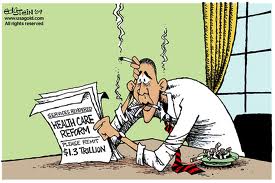- Two Thanksgiving Thoughts for the ACAPosted 12 years ago
- Shop til you Drop at the Healthcare Marketplace Part 2: Frustration!Posted 12 years ago
- An Early Casualty in the Affordable Care FightPosted 12 years ago
- Some Good News for a ChangePosted 12 years ago
Reforming Health Care in The US: A Tutorial (Part 1)

 This year’s presidential election will be, among other things, a referendum on Health Care Reform and the Affordable Health Care Act of 2010. We may have to stop and remind ourselves of that periodically in the next seven weeks, because each week seems to bring a new issue-du-jour. This week it was Romney on foreign policy, provoked by more unrest in the Middle East. A number of people, including Republicans, felt he opened his mouth only to change feet. Net week it will be ?. One sure bet, Health Care Reform can never be far away.
This year’s presidential election will be, among other things, a referendum on Health Care Reform and the Affordable Health Care Act of 2010. We may have to stop and remind ourselves of that periodically in the next seven weeks, because each week seems to bring a new issue-du-jour. This week it was Romney on foreign policy, provoked by more unrest in the Middle East. A number of people, including Republicans, felt he opened his mouth only to change feet. Net week it will be ?. One sure bet, Health Care Reform can never be far away.
 As we have written in this journal in past entries, the ACA was not exactly what we needed. It addressed access right away, giving care to many who had been denied it. But it does not solve the cost problem which is driving the current crisis. Even if we wanted to say give Medicare to every American tomorrow, we could not afford to do that now, given the price of American medicine. Ironically we might have in 1965 when Lyndon Johnson lead the passage of Medicare and Medicaid. Medical care and insurance cost a lot less then. Some observers of the day predicted that guaranteeing care to all Americans lay in the near future.
As we have written in this journal in past entries, the ACA was not exactly what we needed. It addressed access right away, giving care to many who had been denied it. But it does not solve the cost problem which is driving the current crisis. Even if we wanted to say give Medicare to every American tomorrow, we could not afford to do that now, given the price of American medicine. Ironically we might have in 1965 when Lyndon Johnson lead the passage of Medicare and Medicaid. Medical care and insurance cost a lot less then. Some observers of the day predicted that guaranteeing care to all Americans lay in the near future.
It didn’t, but that’s a whole other lesson in history. Many observers point out that it will be hard for the Republicans to scrap the whole bill if they win in November because certain provisions have become rather popular. Parents with 24 year-olds out of work and at home like the fact that they can extend their own coverage to them. Others with past medical problems now are being covered for the first time in years.
It will also be hard for Democrats not to return to the reform table because although costs have plateaued again and the number of uninsured has gone down for the first time in decades, health care keeps getting more expensive because technology drives prices up and will continue to do so. This must finally be confronted. Republicans, ranting and raving about the size of the national debt, will insist on this, especially if they lose, in spite of the fact that they have contributed mightily to the number themselves in recent times.
Tom Godfrey









Health care reform seems to be the battle ground between the wants and needs of society. We all want to have the latest and best health care. We need to come to grips with the reality that we can not afford that. The wants feel they have a right to health care and an inequality in society is depriving them of that. The needs feel there really is no discussion unless it can be payed for. You are entitled to what you can pay for. Can’t continue to spend what we don’t have. This is eventually going to reach a fiscal critical mass, meltdown and implosion.
I think the middle of the road needs to be reached where everyone understands that resources are finite and within that budget we need to get the most that we can. This is where are the innovation, efficiency and budgeting comes in. The trickier part is getting everyone to pay a fair share. This philosophical hurdle may be the most difficult. At some point, we may have been able to function at the individual freedom level. We should always work to preserve that as much as possible. Today, its a bit different than 1787. “Mine” and individual property does not end at the fence of the 10,000 acre ranch. The complex interdependence we have dictates rethinking the definition. I believe that is where we are stuck.
Society sorts out needs from desires. We find our needs are relative to what others are experiencing. We have a lot and expect a lot. How we allot out our finite resources in the face of all that will be a challenge in the years ahead.